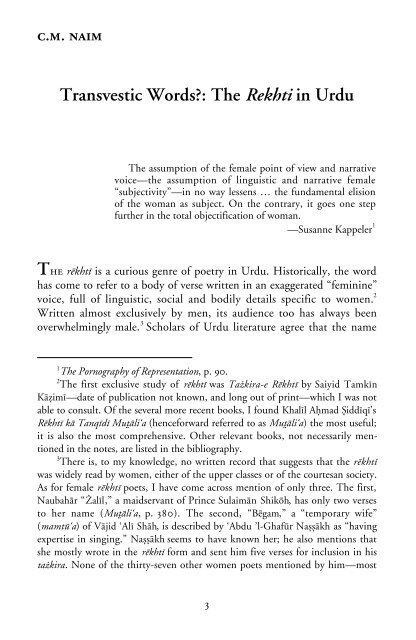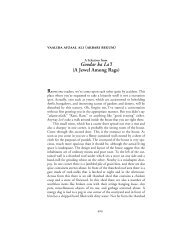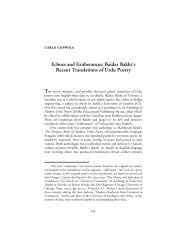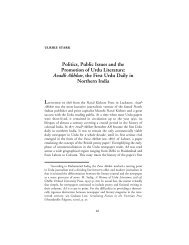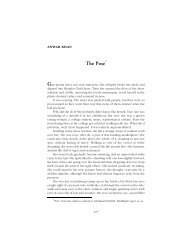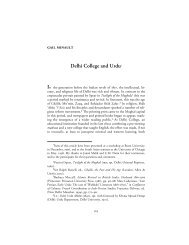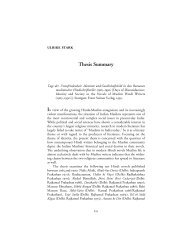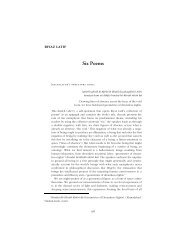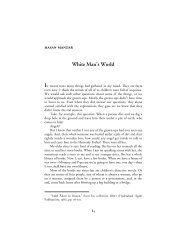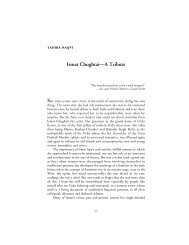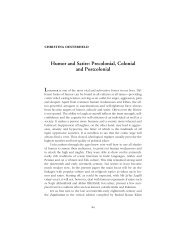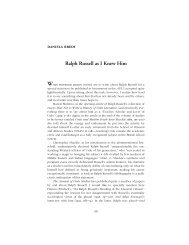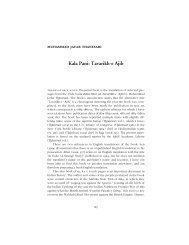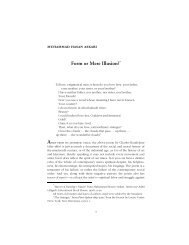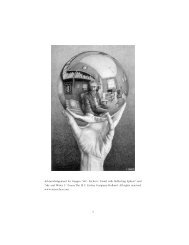Transvestic Words?: The Rekhti in Urdu ThE r®khtµ is a curious
Transvestic Words?: The Rekhti in Urdu ThE r®khtµ is a curious
Transvestic Words?: The Rekhti in Urdu ThE r®khtµ is a curious
Create successful ePaper yourself
Turn your PDF publications into a flip-book with our unique Google optimized e-Paper software.
C.M. NAIM<br />
<strong>Transvestic</strong> <strong>Words</strong>?: <strong>The</strong> <strong>Rekhti</strong> <strong>in</strong> <strong>Urdu</strong><br />
<strong>The</strong> assumption of the female po<strong>in</strong>t of view and narrative<br />
voice—the assumption of l<strong>in</strong>gu<strong>is</strong>tic and narrative female<br />
“subjectivity”—<strong>in</strong> no way lessens … the fundamental el<strong>is</strong>ion<br />
of the woman as subject. On the contrary, it goes one step<br />
further <strong>in</strong> the total objectification of woman.<br />
—Susanne Kappeler 1<br />
THE r®khtµ <strong>is</strong> a <strong>curious</strong> genre of poetry <strong>in</strong> <strong>Urdu</strong>. H<strong>is</strong>torically, the word<br />
has come to refer to a body of verse written <strong>in</strong> an exaggerated “fem<strong>in</strong><strong>in</strong>e”<br />
voice, full of l<strong>in</strong>gu<strong>is</strong>tic, social and bodily details specific to women. 2<br />
Written almost exclusively by men, its audience too has always been<br />
overwhelm<strong>in</strong>gly male. 3 Scholars of <strong>Urdu</strong> literature agree that the name<br />
1 <strong>The</strong> Pornography of Representation, p. 90.<br />
2 <strong>The</strong> first exclusive study of r®khtµ was Taÿkira-e R®khtµ by Saiyid Tamkµn<br />
K≥ imµ—date of publication not known, and long out of pr<strong>in</strong>t—which I was not<br />
able to consult. Of the several more recent books, I found Khalµl A√mad ¿iddµqµ’s<br />
R®khtµ k≥ Tanqµdµ Muπ≥li‘a (henceforward referred to as Muπ≥li‘a) the most useful;<br />
it <strong>is</strong> also the most comprehensive. Other relevant books, not necessarily mentioned<br />
<strong>in</strong> the notes, are l<strong>is</strong>ted <strong>in</strong> the bibliography.<br />
3 <strong>The</strong>re <strong>is</strong>, to my knowledge, no written record that suggests that the r®khtµ<br />
was widely read by women, either of the upper classes or of the courtesan society.<br />
As for female r®khtµ poets, I have come across mention of only three. <strong>The</strong> first,<br />
Naubah≥r “Ÿalµl,” a maidservant of Pr<strong>in</strong>ce Sulaim≥n Shikåh, has only two verses<br />
to her name (Muπ≥li‘a, p. 380). <strong>The</strong> second, “B®gam,” a “temporary wife”<br />
(mamt∑‘a) of V≥jid ‘Alµ Sh≥h, <strong>is</strong> described by ‘Abdu ’l-Ghaf∑r NaΩΩ≥kh as “hav<strong>in</strong>g<br />
expert<strong>is</strong>e <strong>in</strong> s<strong>in</strong>g<strong>in</strong>g.” NaΩΩ≥kh seems to have known her; he also mentions that<br />
she mostly wrote <strong>in</strong> the r®khtµ form and sent him five verses for <strong>in</strong>clusion <strong>in</strong> h<strong>is</strong><br />
taÿkira. None of the thirty-seven other women poets mentioned by him—most<br />
3
4 • THE ANNUAL OF URDU STUDIES<br />
r®khtµ was co<strong>in</strong>ed by the eighteenth-century poet Ragµn to designate certa<strong>in</strong><br />
verses that he wrote for the enterta<strong>in</strong>ment of h<strong>is</strong> patron, Mirz≥<br />
Sulaim≥n Shikåh, a Mughal pr<strong>in</strong>ce then liv<strong>in</strong>g <strong>in</strong> exile <strong>in</strong> Lucknow. 4<br />
Sa‘≥dat Y≥r Kh≥n, Ragµn (1755–1835), 5 was tra<strong>in</strong>ed by h<strong>is</strong> father to be<br />
a soldier of fortune, but he mostly earned h<strong>is</strong> liv<strong>in</strong>g as a tra<strong>in</strong>er and trader<br />
of horses, or as a poet/courtier at various places. He eventually organized<br />
h<strong>is</strong> copious writ<strong>in</strong>gs <strong>in</strong>to n<strong>in</strong>e books, <strong>in</strong>clud<strong>in</strong>g two dµv≥ns of conventional<br />
ghazals, one of heterosexually explicit verses, and a fourth of r®khtµs.<br />
In the <strong>in</strong>troduction to the latter, Ragµn noted that <strong>in</strong> Delhi he used to<br />
patronize kh≥ngµs a great deal, and always paid much attention to their<br />
speech. 6 Consequently, he came to know their idiom well and composed<br />
verses <strong>in</strong> it, call<strong>in</strong>g them “r®khtµ”—as opposed to “r®khta,” which was the<br />
term then commonly used to refer to the <strong>Urdu</strong> ghazal and also the language.<br />
More tell<strong>in</strong>g, perhaps, was the title that he gave to that collection:<br />
Ag®khta (the aroused [verses]). <strong>The</strong> thematic contents of Ragµn’s<br />
“aroused” verses may be summarized as follows: adulterous sex between<br />
men and women; sex between women; lustful women; quarrelsome<br />
women; jealous women; women’s superstitions and rituals; women’s<br />
exclusive bodily functions; women’s clothes and jewelry; and a variety of<br />
of them courtesans—wrote <strong>in</strong> that manner. (Sukhan-e Shu‘ar≥’, p. 573.) Ragµn<br />
himself quotes one r®khtµ by an alleged female sh≥gird of h<strong>is</strong>—he gives only her<br />
takhalluΩ, B®gham—<strong>in</strong> h<strong>is</strong> anecdotal book, Maj≥l<strong>is</strong>-e Ragµn. He claims that her<br />
r®khtµ was a flirtatious rejo<strong>in</strong>der to some of h<strong>is</strong> own verses. Th<strong>is</strong> could be merely a<br />
poetic conceit. (Maj≥l<strong>is</strong>-e Ragµn, pp. 70–1.)<br />
4<br />
Mirz≥ Sulaim≥n Shikåh arrived <strong>in</strong> Lucknow from Delhi <strong>in</strong> 1790 and resided<br />
there as a guest of the Navabs of Avadh till sometime <strong>in</strong> 1828, when he left for<br />
Kasgunj and then for Agra, where he died <strong>in</strong> 1837. See Saiyid Kamalu ’d-Dµn<br />
ƒaidar, a.k.a. Saiyid Mu√ammad Mµr Z≥’ir, Tav≥rµkh-e Avad^, vol. I (Lucknow:<br />
Naval K<strong>is</strong>hore Press, 1907), p. 280. <strong>The</strong> pr<strong>in</strong>ce also patronized ¿≥√ib Qir≥n, the<br />
most notorious poet of sexually explicit verses <strong>in</strong> <strong>Urdu</strong>. See footnote 36 below.<br />
5 <strong>The</strong> only major study of Ragµn <strong>is</strong> ¿≥bir ‘Alµ Kh≥n’s Sa‘≥dat Y≥r Kh≥n<br />
Ragµn. Not all of Ragµn’s poetic works have yet been publ<strong>is</strong>hed. Autograph<br />
manuscripts of h<strong>is</strong> n<strong>in</strong>e books are <strong>in</strong> the collection of the Brit<strong>is</strong>h Library,<br />
London.<br />
6<br />
Kh≥ngµ: “parda-n<strong>is</strong>hµn [i.e., purdah-observ<strong>in</strong>g] women who surreptitiously<br />
engage <strong>in</strong> prostitution <strong>in</strong> their homes” (Saiyid A√mad Dehlavµ, Farhag-e ¥Ωafµya).
C.M. NAIM • 5<br />
mundane events <strong>in</strong> the domestic life of women. 7<br />
Insh≥’u ’l-L≥h Kh≥n, Insh≥ (1756–1817), 8<br />
a polyglot, multi-talented<br />
poet, who also wrote many r®khtµs, was a close friend of Ragµn. In Dary≥e<br />
Laπ≥fat, h<strong>is</strong> delightful book on the <strong>Urdu</strong> language, Insh≥ has a testy old<br />
Delhiite liv<strong>in</strong>g <strong>in</strong> Lucknow decry the quality of local poets and poetry,<br />
<strong>in</strong>clud<strong>in</strong>g the follow<strong>in</strong>g on Ragµn: “Because he <strong>is</strong> an avid patron of prostitutes<br />
[ran≈µ], Ragµn’s m<strong>in</strong>d has taken to vulgarity and lewdness [shuhudpan].<br />
Consequently, putt<strong>in</strong>g aside r®khta, he has <strong>in</strong>vented r®khtµ, hop<strong>in</strong>g<br />
that young women of good families would read h<strong>is</strong> verses and fall for him<br />
and that he would then ‘blacken h<strong>is</strong> face’ with them.” Elsewhere <strong>in</strong> the<br />
same book, Insh≥ <strong>is</strong> only slightly more politic as he aga<strong>in</strong> credits Ragµn<br />
with the <strong>in</strong>vention of the r®khtµ. 9<br />
<strong>The</strong> term “r®khtµ” may <strong>in</strong>deed have been co<strong>in</strong>ed by Ragµn, but contrary<br />
to h<strong>is</strong> and Insh≥’s claims, the k<strong>in</strong>d of verse it denoted was not h<strong>is</strong><br />
<strong>in</strong>vention. 10 Several poets had already written similar verses <strong>in</strong> Bijapur<br />
and Hyderabad. In fact Ragµn may have come across their verse dur<strong>in</strong>g<br />
h<strong>is</strong> many travels or even while <strong>in</strong> Delhi, before h<strong>is</strong> arrival <strong>in</strong> Lucknow<br />
around 1789. Both Khalµl A√mad ¿iddµqµ and Badµ‘ ƒusa<strong>in</strong>µ l<strong>is</strong>t several<br />
poets of the Deccan who preceded Ragµn, and suggest that the verses of<br />
one of them, Mu√ammad ¿iddµq, Qa<strong>is</strong> (d. 1814?)—a slightly older con-<br />
7 How these matters were considered “enterta<strong>in</strong><strong>in</strong>g” <strong>in</strong> the <strong>Urdu</strong> milieu of<br />
the late eighteenth century, and why they are seen <strong>in</strong> the same light even now,<br />
were perhaps the primary questions that triggered th<strong>is</strong> paper.<br />
8<br />
Insh≥ has deservedly received more attention than Ragµn. Most of h<strong>is</strong><br />
prose and poetry <strong>is</strong> now available <strong>in</strong> carefully edited editions.<br />
9 Insh≥, Dary≥-e Laπ≥fat, pp. 96–7. <strong>The</strong> second quotation <strong>is</strong> found on p. 171,<br />
but it leaves out a sentence about Ragµn’s sexual proclivity. <strong>The</strong> orig<strong>in</strong>al Persian<br />
<strong>is</strong> quoted by Badµ‘ ƒusa<strong>in</strong>µ (Dakan M® R®khtµ k≥ Irtiq≥’, p. 27), and may be<br />
translated: “...Ragµn ... who <strong>is</strong> the noblest <strong>in</strong> friendship and <strong>in</strong> the manly art of<br />
soldier<strong>in</strong>g, and who long rode the charger of h<strong>is</strong> ambition <strong>in</strong> the field of virility<br />
[b≥h], has had much experience with the women of purdah [zan≥n-e pardan<strong>is</strong>hµn].<br />
He has written a few pages on their language, and also a volume of verses<br />
<strong>in</strong> that language. He <strong>is</strong> the <strong>in</strong>ventor of the r®khtµ ….”<br />
10 Not only <strong>is</strong> Ragµn’s claim to have <strong>in</strong>vented the r®khtµ on h<strong>is</strong> own quite<br />
doubtful, even the special glossary attribturted to Ragµn by Insh≥ <strong>is</strong> not h<strong>is</strong>.<br />
Imti≥z ‘Alµ Kh≥n ‘Arshµ compared Ragµn’s text with a similar compilation by<br />
Sir≥ju ’d-Dµn ‘Alµ Kh≥n, ¥rz∑ (1687?–1756), the famous grammarian and lexicographer,<br />
and found Ragµn’s l<strong>is</strong>t to be a literal translation of ¥rz∑’s f<strong>in</strong>d<strong>in</strong>gs.<br />
(Yakt≥, Dast∑ru ’l-FaΩ≥√at, Introduction, p. 2. footnote 1.)
6 • THE ANNUAL OF URDU STUDIES<br />
temporary of Ragµn—could have provided the <strong>in</strong>spiration for Ragµn’s<br />
alleged <strong>in</strong>vention. 11<br />
Neither, however, credits Qa<strong>is</strong> with <strong>in</strong>vent<strong>in</strong>g the<br />
r®khtµ. That d<strong>is</strong>t<strong>in</strong>ction, accord<strong>in</strong>g to them, belongs to Saiyid Mµr≥,<br />
H≥shimµ (d. ca. 1697), who spent most of h<strong>is</strong> life <strong>in</strong> Burhanpur and<br />
Bijapur. 12<br />
H≥shimµ was not attached to the Adil Shahi court; he did,<br />
however, have many patrons among the nobility. Reportedly he was<br />
bl<strong>in</strong>d, though perhaps not from birth.<br />
Before H≥shimµ, the ghazal <strong>in</strong> Dakani was written <strong>in</strong> what we might<br />
roughly call two modes: the “Persian” and the “Indic.” In the “Persian”<br />
mode, the poet used a mascul<strong>in</strong>e voice for himself, and addressed a<br />
beloved who could be male or female. (Th<strong>is</strong> mode later ga<strong>in</strong>ed exclusive<br />
dom<strong>in</strong>ance <strong>in</strong> the <strong>Urdu</strong> ghazal <strong>in</strong> all parts of India.) In the “Indic” mode,<br />
on the other hand, the poet/lover adopted a fem<strong>in</strong><strong>in</strong>e voice for himself,<br />
while address<strong>in</strong>g a beloved who was always male. Dakani poets freely used<br />
the two modes, frequently us<strong>in</strong>g both <strong>in</strong> the same ghazal. In either case,<br />
the dom<strong>in</strong>ant themes for them were love—mystical or carnal—and its<br />
pa<strong>in</strong>s and pleasures, and not the topics mentioned earlier as peculiar to<br />
the r®khtµ.<br />
H≥shimµ seems to have done two new th<strong>in</strong>gs: (1) he added the domestic<br />
life of the women of élite households to the thematic range of h<strong>is</strong><br />
ghazals, and (2) he made the language of the “Indic” mode replete with a<br />
peculiarly fem<strong>in</strong><strong>in</strong>e vocabulary. H<strong>is</strong> publ<strong>is</strong>hed dµv≥n conta<strong>in</strong>s 305 ghazals,<br />
out of which 240 are identical <strong>in</strong> content with what later came to be<br />
called r®khtµs. Significantly, H≥shimµ does not separate the latter <strong>in</strong>to a<br />
d<strong>is</strong>t<strong>in</strong>ct group; <strong>in</strong> fact he frequently has the “r®khtµ” and “non-r®khtµ”<br />
verses <strong>in</strong> the same ghazal. But he <strong>is</strong> def<strong>in</strong>itely aware of the difference<br />
between h<strong>is</strong> new verse and the ghazal <strong>in</strong> the so-called “Indic” mode. In<br />
one maqπa‘ he has h<strong>is</strong> poetic persona declare: “diy® hai H≥shimµ ‘izzat<br />
ham≥rµ ∑µ kµ bålµ k∑,” (“H≥shimµ has given dignity to our ∑µ kµ bålµ”), ∑µ<br />
be<strong>in</strong>g an exclusively fem<strong>in</strong><strong>in</strong>e exclamation of surpr<strong>is</strong>e. In a couplet <strong>in</strong><br />
11<br />
Muπ≥li‘a, pp. 237–8; ƒusa<strong>in</strong>µ, p. 138 ff. ƒusa<strong>in</strong>µ details the remarkable similarity<br />
between some of the r®khtµs of the two poets. Qa<strong>is</strong>’s dµv≥n of r®khtµs has not<br />
been publ<strong>is</strong>hed, but three manuscripts are available at Hyderabad. In one there <strong>is</strong><br />
a statement to the effect that the poet used “the idiom of the vivacious [shåkh]<br />
b®gams of the imperial palaces of Shahjahanabad.” Qa<strong>is</strong> clearly was try<strong>in</strong>g to make<br />
h<strong>is</strong> wares appear more “exotic” to h<strong>is</strong> patrons.<br />
12<br />
E√s≥nu ’l-L≥h’s <strong>is</strong> the only full-length study of H≥shimµ. J≥libµ also has a<br />
long section devoted to th<strong>is</strong> poet (pp. 354–69). ƒafµ Qatµl’s edition of H≥shimµ’s<br />
verse <strong>is</strong> quite dependable.
C.M. NAIM • 7<br />
another ghazal he says, “bål® hai kh∑b b^åtic ghazl≥ b^µ kaµ zan≥nµ” (“…<br />
you have also composed many f<strong>in</strong>e zan≥nµ (fem<strong>in</strong><strong>in</strong>e) ghazals”). Elsewhere<br />
<strong>in</strong> the dµv≥n, however, he refers to h<strong>is</strong> compositions simply as ghazals. No<br />
contemporary of H≥shimµ seems to have emulated him. 13<br />
It should be underscored here that it was not just hav<strong>in</strong>g a female<br />
narrative voice that differentiated the r®khtµ from other genres, for that<br />
alone could be true of any number of ghazals written <strong>in</strong> Dakani that are<br />
now described as be<strong>in</strong>g <strong>in</strong> the “Indic” mode. (In fact, <strong>in</strong> many verses of<br />
H≥shimµ and Insh≥ we can d<strong>is</strong>cern a male address<strong>in</strong>g a female.) Rather,<br />
the chief d<strong>is</strong>t<strong>in</strong>gu<strong>is</strong>h<strong>in</strong>g feature was the so-called “fem<strong>in</strong><strong>in</strong>e-ness” of its<br />
vocabulary and themes. That becomes clear from the def<strong>in</strong>ition set forth<br />
by A√ad ‘Alµ Kh≥n Yakt≥, who f<strong>in</strong><strong>is</strong>hed h<strong>is</strong> taÿkira <strong>in</strong> 1834, not too long<br />
after Ragµn and Insh≥ had popularized the r®khtµ <strong>in</strong> Lucknow: “R®khtµ <strong>is</strong> a<br />
k<strong>in</strong>d of poetry <strong>in</strong> which only the speech and idioms of women are used<br />
and only those matters are mentioned that happen between women or<br />
between a woman and a man. Further, it must not conta<strong>in</strong> any word or<br />
phrase that <strong>is</strong> exclusive to men.” 14<br />
Additionally, on the bas<strong>is</strong> of our own read<strong>in</strong>gs of the r®khtµs of<br />
H≥shimµ, Ragµn, and Insh≥, we may posit three other differences between<br />
the r®khtµ and the r®khta, the conventional ghazal, of which the former<br />
was implied by Ragµn and Insh≥ to have been the “fem<strong>in</strong><strong>in</strong>e” form.<br />
(1) Compared to the usually multi-valenced and/or symbolic language<br />
of the ghazal, the language of the r®khtµ <strong>is</strong> almost crudely real<strong>is</strong>tic, and<br />
devoid of any ambiguity or multiplicity of referents. Its mean<strong>in</strong>g <strong>is</strong> fixed.<br />
(2) In the ghazal, the averred protagon<strong>is</strong>ts are never named; they<br />
rema<strong>in</strong> simply “the lover,” “the beloved,” and so forth. In the r®khtµ, however,<br />
proper names may be used, though only <strong>in</strong> a non-specify<strong>in</strong>g manner.<br />
Interest<strong>in</strong>gly, th<strong>is</strong> also happens <strong>in</strong> the hazl, i.e., <strong>in</strong> sexually explicit<br />
humorous poetry—for example <strong>in</strong> such verses of Ragµn and ¿≥√ib<br />
Qir≥n—suggest<strong>in</strong>g that there could be some shared goals or <strong>in</strong>tentions<br />
underly<strong>in</strong>g the two genres.<br />
(3) Whereas <strong>in</strong> the ghazal the object of the lover’s passion <strong>is</strong> celebrated<br />
and idealized, there <strong>is</strong> <strong>in</strong> the r®khtµ no grand passion and, consequently,<br />
no idealization of the desired object either. In fact the r®khtµ<br />
13 Accord<strong>in</strong>g to Khalµl A√mad ¿iddµqµ, H≥shimµ found some followers only<br />
much later <strong>in</strong> Hyderabad, one of them be<strong>in</strong>g the above-mentioned Qa<strong>is</strong>, whose<br />
verses, he argues, provided Ragµn with h<strong>is</strong> model.<br />
14<br />
Yakt≥, Dast∑ru ’l-FaΩ≥√at, “Text,” p. 97.
8 • THE ANNUAL OF URDU STUDIES<br />
often seems to mock or denigrate the object of desire.<br />
Only one more major poet needs to be mentioned to conclude th<strong>is</strong><br />
h<strong>is</strong>torical section: Mµr Y≥r ‘Alµ, J≥n ¿≥√ib (1810–1886). Born <strong>in</strong> Farrukhabad,<br />
he grew up <strong>in</strong> Lucknow and also spent much of h<strong>is</strong> life there. 15<br />
After the d<strong>is</strong>solution of the k<strong>in</strong>gdom of Avadh <strong>in</strong> 1856, he briefly lived <strong>in</strong><br />
Bhopal and Delhi before eventually settl<strong>in</strong>g <strong>in</strong> Rampur, where he enjoyed<br />
the patronage of the local navab. In contrast to the earlier masters, J≥n<br />
¿≥√ib wrote exclusively <strong>in</strong> the r®khtµ mode. He, however, modified and<br />
widened its thematic parameters with great skill and imag<strong>in</strong>ation. He<br />
m<strong>in</strong>imized, if not entirely d<strong>is</strong>carded, the subject of lesbian sex,<br />
highlighted the life of married women and their relationships with members<br />
of their extended families, made comments on life outside the conf<strong>in</strong>es<br />
of the household and, like Ragµn, wrote several other types of topical<br />
poems <strong>in</strong> the language of the r®khtµ.<br />
Subsequent r®khtµ poets, <strong>in</strong>clud<strong>in</strong>g our own contemporaries, have<br />
modeled themselves after J≥n ¿≥√ib. With the passage of time, the use of<br />
sexually explicit language and the mention of lesbian sex has d<strong>is</strong>appeared<br />
completely; <strong>in</strong>stead, there now appears an <strong>in</strong>creas<strong>in</strong>g concern with social<br />
and political <strong>is</strong>sues and a somewhat sympathetic view of women. But an<br />
exaggerated, presumably “fem<strong>in</strong><strong>in</strong>e” voice still rema<strong>in</strong>s its d<strong>is</strong>t<strong>in</strong>ctive<br />
feature, as does its avowed function as “enterta<strong>in</strong>ment.” 16<br />
*<br />
<strong>The</strong> thematic developments <strong>in</strong> the r®khtµ, from H≥shimµ to J≥n ¿≥√ib and<br />
later, may be summarized as follows:<br />
H≥shimµ: wrote conventional ghazals <strong>in</strong> both the “Indic” and<br />
“Persian” modes, sometimes even <strong>in</strong> the same ghazal; placed h<strong>is</strong> r®khtµ and<br />
conventional ghazals <strong>in</strong> the same dµv≥n; while ma<strong>in</strong>ly employ<strong>in</strong>g<br />
“real<strong>is</strong>tic” language <strong>in</strong> h<strong>is</strong> r®khtµs, also made some use of conventional<br />
“symbols”; d<strong>is</strong>played a didactic <strong>in</strong>tention by offer<strong>in</strong>g advice on domestic<br />
behavior to women; made fun of the “peev<strong>is</strong>h” woman, but quite <strong>in</strong>frequently;<br />
17 and mentioned only heterosexual acts. Examples:<br />
15<br />
J≥n ¿≥√ib’s dµv≥n was publ<strong>is</strong>hed <strong>in</strong> h<strong>is</strong> life <strong>in</strong> 1845, but that edition <strong>is</strong> not<br />
extant. Even the carefully edited, but expurgated, editions put out by Ni ≥mµ<br />
Bad≥y∑nµ, <strong>in</strong> 1923 and <strong>in</strong> 1927, are now hard to come by.<br />
16<br />
Khalµl A√mad ¿iddµqµ br<strong>in</strong>gs the story to the 1920s. Later poets are mentioned<br />
by ‘Abb≥sµ.<br />
17 Th<strong>is</strong> peev<strong>is</strong>h woman will be d<strong>is</strong>cussed <strong>in</strong> more detail below.
C.M. NAIM • 9<br />
kh≥v<strong>in</strong>d kµ apn® ai nan^µ s®vak hå nit s®v≥ karå<br />
har k<strong>is</strong> kµ sunkar b≥t ±up n≥ kar nashar sh®v≥ karå<br />
You’re your husband’s maid, little girl, so serve him constantly.<br />
Don’t spread gossip for noth<strong>in</strong>g—make that a habit.<br />
on∑ ≥v® tå pard® så g^a∞µ b^ar b^≥r baiª^∑gµ<br />
bah≥na kar-ke måtiyan k® piråt® h≥r baiª^∑gµ<br />
If he comes I shall sit outside for a moment, unveiled, pretend<strong>in</strong>g<br />
that I was str<strong>in</strong>g<strong>in</strong>g pearls <strong>in</strong>to a necklace.<br />
ajµ mai p®ª t® h∑ ±^å∞å m®rµ p®shv≥z k≥ d≥man<br />
hå®g≥ g^år ulum muj^ par, jud≥ hån® s® ≈artµ h∑<br />
Hey, let go of my gown! I’m pregnant. It will be a terrible<br />
th<strong>in</strong>g—I’m scared I may lose the baby.<br />
laª≥paª m® ª∑ª® hai kåµ y∑ band d®k^® tå hai mushkil<br />
bi±≥rµ s≥s m<strong>is</strong>kµ hai nanad d®k^® tå hai mushkil<br />
<strong>The</strong> ties of my gown got torn <strong>in</strong> the tussle—it would be awful if<br />
someone sees. My mother-<strong>in</strong>-law <strong>is</strong> harmless, but it would be<br />
terrible if my s<strong>is</strong>ter-<strong>in</strong>-law notices.<br />
kah≥ ky≥ ‘aib hai bålå jå sµn≥ h≥t^ så ±^µn® k≥<br />
kahµ mai jµ-i± d∑gµ hå jå l®g® n≥å sµn® k≥<br />
I said, “What’s the harm if I touch your breasts?” She replied, “I’d<br />
kill myself if you’d even mention my breasts.”<br />
Qa<strong>is</strong>, Ragµn, and Insh≥: wrote conventional ghazals only <strong>in</strong> the<br />
“Persian” mode; 18 used only “real<strong>is</strong>tic” language <strong>in</strong> their r®khtµs; separately<br />
organized their r®khtµ and conventional ghazals; d<strong>is</strong>played no didactic<br />
<strong>in</strong>tention, aim<strong>in</strong>g only to “enterta<strong>in</strong>”; made conspicuous fun of the<br />
“peev<strong>is</strong>h” woman; and mentioned both lesbian and heterosexual acts.<br />
Examples:<br />
k≥h® kå pahn∑gµ, b≥jµ, mai tum^≥rµ agiy≥<br />
®k s® ®k m®r® p≥s hai b^≥rµ agiy≥ (Qa<strong>is</strong>)<br />
Why should I wear your bodice, s<strong>is</strong>ter? I have my own, each richer<br />
than the other.<br />
r≥t kåª^® pe t®rµ d®k^ lµ ±årµ ann≥<br />
18 Th<strong>is</strong> statement <strong>is</strong> restricted to Ragµn and Insh≥; I had no access to the<br />
actual collections of Qa<strong>is</strong>’s poetry.
10 • THE ANNUAL OF URDU STUDIES<br />
k≥lµ ∑par t^µ ±a∞^µ nµ±® t^µ gå∞µ ann≥ (Qa<strong>is</strong>)<br />
I found out your secret, Nanny, last night on the roof. <strong>The</strong> black<br />
one was on top, Nanny, and the fair one lay underneath her.<br />
ªåkiy≥ ≈^µlµ hai aur tag pi±^≥van m® dad≥<br />
<strong>is</strong> πara√ b^µ koµ sµt≥ hai gav≥rµ agiy≥ (Qa<strong>is</strong>)<br />
<strong>The</strong> cups are loose and the backside <strong>is</strong> tight—no one, Nanny, sews<br />
a bodice <strong>in</strong> such a rustic manner.<br />
guzr® hai ma‘m∑l s® par d<strong>in</strong> do-±and<br />
ab-ke huµ h∑ mai gha¤ab b®-nam≥z (Ragµn)<br />
Twice as many days [of menses] as <strong>is</strong> usual! I never had to m<strong>is</strong>s so<br />
many prayers before.<br />
Ragµn qasam hai t®rµ hµ h∑ mail® sir s® mai<br />
mat k^ål kar-ke m<strong>in</strong>nat-o-z≥rµ iz≥r-band (Ragµn)<br />
I swear to you, Ragµn, I still have a “dirty head.” 19 Don’t <strong>in</strong>s<strong>is</strong>t,<br />
please. Please don’t untie my pajamas.<br />
≥j kyå t∑ n® dog≥na ye Ωab∑r≥ b≥d^≥<br />
ª^®s lagtµ hai, b^al≥ kyå-ki ba±®-d≥n ba±® (Ragµn)<br />
Why did you tie on th<strong>is</strong> dildo, my darl<strong>in</strong>g friend? It hurts. I fear for<br />
my womb.<br />
®k tå shakl ≈ar≥nµ hai terµ bµ±≥ sµ<br />
t<strong>is</strong>-pe ye p^≥∞-ke dµd® muj^® mat g^∑r dad≥ (Ragµn)<br />
As it <strong>is</strong>, your face <strong>is</strong> scary like a ghoul’s, Nanny. Don’t glare at me<br />
with bulg<strong>in</strong>g eyes.<br />
mardu≥ muj^ s® kah® hai ±alå ≥r≥m kar®<br />
j<strong>is</strong> kå ≥r≥m vo samj^® hai vo ≥r≥m hå nauj (Insh≥)<br />
<strong>The</strong> wretched man says to me, “Come, let’s rest for a while.” Sure!<br />
H<strong>is</strong> “rest” would be some rest <strong>in</strong>deed!<br />
s≥r® b^∑tå s® par® hai ye mu≥ khv≥ja khabµ¡<br />
muj^-kå g^∑r≥ hµ kar® hai ye mu≥ khv≥ja khabµ¡ (Insh≥)<br />
He’s worse than any haunt<strong>in</strong>g spirit, th<strong>is</strong> wretched Khv≥ja. 20<br />
just keeps star<strong>in</strong>g at me, th<strong>is</strong> wretched eunuch.<br />
He<br />
19 I.e., “I’m still hav<strong>in</strong>g my period.”<br />
20 <strong>The</strong> eunuch who superv<strong>is</strong>ed a seraglio was called the Khv≥ja Sir≥.
C.M. NAIM • 11<br />
mai to ku±^ k^®lµ nahµ h∑ a<strong>is</strong>µ ka±±µ gåliy≥<br />
jå na samj^∑ bµ-z<strong>in</strong>≥khµ-jµ tum^≥rµ båliy≥ (Insh≥)<br />
I’m not as naïve as you th<strong>in</strong>k, dear z<strong>in</strong>≥khµ. 21 I know what your<br />
words really mean.<br />
J≥n ¿≥√ib: wrote only r®khtµs, though us<strong>in</strong>g many more forms than<br />
others; made fun of the “peev<strong>is</strong>h” woman; mentioned heterosexual acts<br />
almost exclusively; commented on events outside the domestic world;<br />
showed traces of empathy with women; and made some attempt at moralization<br />
directed at women. And that basically rema<strong>in</strong>ed true for those<br />
who came after J≥n ¿≥√ib. Examples:<br />
vo h≥t^≥-p≥µ r≥t kå kµ muj^ s® ≤≥nd Kh≥<br />
ma√ram kat≥ kµ tum n® merµ t≥r-t≥r kµ (J≥n ¿≥√ib)<br />
≤≥nd Kh≥n, you were so rough last night! You tattered my f<strong>in</strong>e cotton<br />
brassiere.<br />
tum agar dåg® na tan-p®ª kå roªµ kap∞≥<br />
ky≥ khud≥ k® b^µ nahµ g^ar m® ª^ik≥n≥ m®r≥ (J≥n ¿≥√ib)<br />
So you won’t even give me a slice of bread and a piece of cloth? Do<br />
you th<strong>in</strong>k I won’t f<strong>in</strong>d shelter <strong>in</strong> God’s house either?<br />
l® ±uk≥ mu^ m® hai lall∑ m®rµ sau bar zub≥<br />
hå gay≥ kab k≥ musalm≥n, ye ky≥ k≥fir hai (J≥n ¿≥√ib)<br />
Lallu has sucked my tongue many a time. He has long been a<br />
Muslim—he’s no k≥fir.<br />
muj^-kå to ≈≥l≥ g^ar m®, firag<strong>in</strong> ke hå murµd<br />
masjid ban≥µ ≥p n® girj≥ k® s≥mn® (J≥n ¿≥√ib)<br />
You brought me home, but you devote yourself to that Engl<strong>is</strong>h<br />
woman. You, sir, built a mosque <strong>in</strong> front of a church!<br />
±≥q∑ tak rak^n≥ na ab g^ar m® Bah≥dur Mirz≥<br />
håt® hai √ukm s® sark≥r k® hat√iy≥r tal≥sh (J≥n ¿≥√ib)<br />
Don’t keep at home even a pocket knife, Bah≥dur Mirz≥; 22<br />
government has ordered searches for weapons.<br />
the<br />
21<br />
Z<strong>in</strong>≥khµ: Accord<strong>in</strong>g to various glossaries of the r®khtµ, when two women<br />
would become very fond of each other they would together hold and snap apart<br />
the w<strong>is</strong>hbone (z<strong>in</strong>≥kh) of a chicken, thus “formaliz<strong>in</strong>g” their love for each other.<br />
22<br />
Bah≥dur Mirz≥ can be a name, and it can also mean, with some irony:<br />
“Brave Mirz≥.”
12 • THE ANNUAL OF URDU STUDIES<br />
Z≥l tå b®shak hai t∑, b®ª≥, agar Rustam nahµ<br />
b≥r då då jår∑å k≥ aur kamar m® kham nahµ (B®gam) 23<br />
You are certa<strong>in</strong>ly a Z≥l, if not a Rustam! 24 You carry two wives and<br />
yet your “back” <strong>is</strong> not bent.<br />
p^ir nam∑µ ‘aurtå par jå na hå t^å∞≥ hai ulm<br />
kaunsilå m® jab koµ b®gam nahµ kh≥nam nahµ (B®gam)<br />
<strong>The</strong>re are no B®gams or Kh≥nams <strong>in</strong> the council houses—no wonder<br />
we women suffer much cruelty.<br />
il≥hµ kh∑n t^∑k®, saut kå hå ‘≥ri¤a sil k≥<br />
uª^≥-kar l® gaµ, j^≥∞∑-p^irµ, baªª≥ merµ sil k≥ (Shaid≥) 25<br />
May God that my rival spit blood and die of consumption! <strong>The</strong><br />
wretch went off with the “pestle” of my “mortar.”<br />
susr≥l m® jå p≥d∑ to maik® m® hå khabar<br />
®k <strong>is</strong>htih≥r nand hai ®k <strong>is</strong>htih≥r s≥s (Shaid≥)<br />
If I fart <strong>in</strong> my husband’s house the news reaches my mother’s<br />
place—my mother-<strong>in</strong>-law and her daughter are a pair of newspapers.<br />
®k tå hai gåd m® aur d∑sr≥ hai p®ª m®<br />
s≥l b^ar s® muj^ pe hai ≥fat pe ≥fat d®k^n≥ (Shaid≥)<br />
I carry one <strong>in</strong> my lap, and another <strong>in</strong> my belly—it’s been one long<br />
year of one trouble after another.<br />
mardu® qaid hu® ‘aurt® ≥z≥d huµ<br />
ka<strong>is</strong>≥ ≥µn ban≥y≥ hai vaπan s® p∑±^å (Sajnµ) 26<br />
Men are cha<strong>in</strong>ed, but women are free. What k<strong>in</strong>d of a constitution<br />
23 ‘¥bid Mirz≥, B®gam, was born <strong>in</strong> 1857 <strong>in</strong> Lucknow, grew up <strong>in</strong> Calcutta <strong>in</strong><br />
the household of the exiled K<strong>in</strong>g of Avadh, and eventually lived <strong>in</strong> Hyderabad<br />
(Muπ≥li‘a, pp. 472–82).<br />
24<br />
Z≥l was the father of Rustam, the legendary Iranian warrior.<br />
25<br />
Ni¡≥r ƒusa<strong>in</strong> Kh≥n, Shaid≥ (b. 1868?), of Allahabad; publ<strong>is</strong>hed h<strong>is</strong> collection<br />
of r®khtµs <strong>in</strong> 1932. (Muπ≥li‘a, pp. 490–511).<br />
26<br />
Saiyid S≥jid, Sajnµ (1922–93?), was orig<strong>in</strong>ally from Lucknow but spent<br />
much of h<strong>is</strong> life <strong>in</strong> Bhopal. H<strong>is</strong> collection, Nigå∞iy≥t, was publ<strong>is</strong>hed <strong>in</strong> 1987.<br />
Interest<strong>in</strong>gly, he took to R®khtµ, by h<strong>is</strong> own adm<strong>is</strong>sion, only after mov<strong>in</strong>g to<br />
Bhopal, and after realiz<strong>in</strong>g that he was never go<strong>in</strong>g to make a name as a ghazal<br />
poet.
C.M. NAIM • 13<br />
<strong>is</strong> th<strong>is</strong>?<br />
c≥r kark® vo itr≥® hai<br />
das kar∑ mai agar bas ±al® (Sajnµ)<br />
He smirks because he took “four.” If I had my way, I’d take “ten.”<br />
πal≥q d® to rah® hå ‘it≥b-o-qahr k® s≥t^<br />
m®r≥ shab≥b b^µ lauª≥då mer® mahr k® s≥t^ (Sajnµ)<br />
So you’re greatly enraged and divorc<strong>in</strong>g me? Go ahead, but you<br />
should also give my youth back when you give me my mahr. 27<br />
*<br />
Modern h<strong>is</strong>torians of <strong>Urdu</strong> literature do not shy away from mention<strong>in</strong>g<br />
the r®khtµ <strong>in</strong> their accounts, but one gets the impression that they feel<br />
uneasy around the subject. In the only book-length study of H≥shimµ’s<br />
poetry, Mu√ammad E√s≥nu ’l-L≥h tries hard to establ<strong>is</strong>h him as a poet of<br />
rectitude and decency. Accord<strong>in</strong>g to E√s≥nu ’l-L≥h, “H≥shimµ’s r®khtµ was<br />
not devoted to enterta<strong>in</strong>ment and sensuality.… He has often kept a purpose<br />
before himself: to direct women towards a life of decency and<br />
morality.” 28 Accord<strong>in</strong>gly, when E√s≥nu ’l-L≥h classifies H≥shimµ’s verses<br />
by their contents, he sets up six categories: (1) love thoughts of an unmarried<br />
woman; (2) love thoughts of a wife for her husband; (3) jealous<br />
thoughts of a wife towards her rival; (4) events of daily life; (5) advice to<br />
women; and (6) erotic <strong>in</strong>teractions [mu‘≥mala-bandµ]. To further underscore<br />
h<strong>is</strong> po<strong>in</strong>t, he claims that though he exam<strong>in</strong>ed more than three thousand<br />
couplets by H≥shimµ, no more than two hundred could he call<br />
mubtaÿal or vulgar. Apparently he does not th<strong>in</strong>k that one <strong>in</strong> fifteen was<br />
high enough a number to <strong>in</strong>dicate some proclivity on H≥shimµ’s part<br />
when he had already <strong>in</strong>cluded H≥shimµ’s other openly erotic verses <strong>in</strong> two<br />
“non-vulgar” categories. E√s≥nu ’l-L≥h concedes that one can f<strong>in</strong>d a<br />
“shameless woman” <strong>in</strong> H≥shimµ’s verses, but asserts that such verses come<br />
with others that conta<strong>in</strong> edify<strong>in</strong>g morals. Jamµl J≥libµ, on the other hand,<br />
declares <strong>in</strong> h<strong>is</strong> mag<strong>is</strong>terial h<strong>is</strong>tory of <strong>Urdu</strong> literature that H≥shimµ was<br />
27 Mahr <strong>is</strong> the “bride-money” that a Muslim husband should give to h<strong>is</strong> wife<br />
before the marriage may be consummated. In South Asia, unfortunately, th<strong>is</strong> rule<br />
<strong>is</strong> hardly ever observed <strong>in</strong> practice—one reason why th<strong>is</strong> couplet was widely<br />
quoted <strong>in</strong> Indian newspapers dur<strong>in</strong>g the famous Shah Bano case <strong>in</strong> the 1980s.<br />
28<br />
E√s≥nu ’l-L≥h, H≥shimµ Bµj≥p∑rµ, pp. 153–4.
14 • THE ANNUAL OF URDU STUDIES<br />
almost s<strong>in</strong>gle-m<strong>in</strong>dedly devoted to erotic, even licentious verses. 29<br />
<strong>The</strong> seem<strong>in</strong>gly wide difference between the two assessments <strong>is</strong>, of<br />
course, very tell<strong>in</strong>g. One soon d<strong>is</strong>covers that each author has a favorite<br />
explanation for the ex<strong>is</strong>tence of the r®khtµ <strong>in</strong> <strong>Urdu</strong>. E√s≥nu ’l-L≥h beg<strong>in</strong>s<br />
by declar<strong>in</strong>g that <strong>Urdu</strong> was unique <strong>in</strong> hav<strong>in</strong>g separate varieties [zab≥n] for<br />
men and women—i.e., <strong>Urdu</strong> conta<strong>in</strong>ed verbs, adjectives, idioms and<br />
proverbs that were uniquely fem<strong>in</strong><strong>in</strong>e. He adds that <strong>Urdu</strong>-speak<strong>in</strong>g<br />
woman were (1) secluded <strong>in</strong> purdah and (2) denied education, and these<br />
two factors enhanced the ex<strong>is</strong>t<strong>in</strong>g difference. In other words, for E√s≥nu<br />
’l-L≥h, the r®khtµ of H≥shimµ was the natural response of a sensitive and<br />
sympathetic poet to an ex<strong>is</strong>t<strong>in</strong>g socio-l<strong>in</strong>gu<strong>is</strong>tic situation. J≥libµ, on the<br />
other hand, believes that when a society beg<strong>in</strong>s to “decl<strong>in</strong>e” it becomes<br />
less “manly” and devotes itself to the pleasures of the senses. Thus for<br />
J≥libµ, the r®khtµ was an <strong>in</strong>evitable consequence of a socio-political situation:<br />
an alleged fall<strong>in</strong>g from grace of the <strong>Urdu</strong>-speak<strong>in</strong>g Muslim community<br />
of India.<br />
<strong>The</strong>se two explanations form the staple for all the studies of the r®khtµ<br />
that I was able to consult. Khalµl A√mad ¿iddµqµ believes that the r®khtµ<br />
was the expression of a society given to sensual pleasure: “When just<br />
talk<strong>in</strong>g about women no longer sat<strong>is</strong>fied them, the poets turned to the<br />
language and sentiments of the women themselves.” 30 An earlier scholar,<br />
Abu ’l-Lai¡ ¿iddµqµ, argues that “Fem<strong>in</strong><strong>in</strong>ity comb<strong>in</strong>ed with obscenity<br />
[n<strong>is</strong>≥iyat aur fo√sh-gå’µ] laid the foundation of the r®khtµ.” 31 For him, the<br />
r®khtµ was worth any attention only because it was a treasure-trove of the<br />
language of the courtesans, particularly of their ref<strong>in</strong>ed and special<br />
idioms. Even ¥gh≥ ƒaidar ƒasan, perhaps the most sympathetic writer on<br />
the subject, beg<strong>in</strong>s by stat<strong>in</strong>g: “When a nation or people’s [qaum]<br />
civilization reaches its highest po<strong>in</strong>t, a decl<strong>in</strong>e sets <strong>in</strong>, then men beg<strong>in</strong> to<br />
d<strong>is</strong>play much more sensuality and peculiarities of habits and fashion<br />
29<br />
J≥libµ, T≥rµkh-e Adab-e Urd∑, vol. I, pp. 364–6.<br />
30<br />
Muπ≥li‘a, p. 93.<br />
31<br />
¿iddµqµ, Lak^nau k≥ Dab<strong>is</strong>t≥n-e Sh≥‘irµ, p. 41; also, “[Ragµn’s r®khtµ <strong>is</strong> not<br />
great poetry] but it has def<strong>in</strong>ite h<strong>is</strong>torical and l<strong>in</strong>gu<strong>is</strong>tic significance. From it we<br />
get a sense of the depths of mental decl<strong>in</strong>e that the society had reached <strong>in</strong> those<br />
days; we also learn about that psychological sickness which, when healthy channels<br />
are closed, forces human feel<strong>in</strong>gs to go astray and seek unnatural ways of<br />
expression. If the r®khtµ has any worthy aspect it <strong>is</strong> only th<strong>is</strong>: <strong>in</strong> it are preserved<br />
the elegance and subtlety of the language of the courtesans and their special<br />
idioms” (p. 362).
C.M. NAIM • 15<br />
[ragµnµ, b≥kpan aur va¤‘-d≥rµ].” 32<br />
Aga<strong>in</strong> and aga<strong>in</strong> we f<strong>in</strong>d <strong>in</strong> these and other authors a sense of shame<br />
at the alleged “fem<strong>in</strong><strong>in</strong>ity” of the r®khtµ, and an attempt to locate the reason<br />
for th<strong>is</strong> “unmanl<strong>in</strong>ess” of the r®khtµ poets <strong>in</strong> the decl<strong>in</strong>e of the political<br />
power of the <strong>Urdu</strong>-speak<strong>in</strong>g Muslims, particularly of North India. 33<br />
Needless to say, <strong>in</strong> different contexts these and other authors reverse their<br />
reason<strong>in</strong>g and allege that a grow<strong>in</strong>g “effem<strong>in</strong>acy” of that society—seen as<br />
synonymous with cultural decl<strong>in</strong>e—was an important cause for that loss<br />
of political power. 34 What they all seem to m<strong>is</strong>s <strong>is</strong> a recognition of the fact<br />
that r®khtµs were written before that so-called “decadent” age, and<br />
cont<strong>in</strong>ued to be written after it.<br />
Pre-modern literary h<strong>is</strong>torians, i.e., the taÿkira-writers, also do not<br />
show much enthusiasm for the r®khtµ. Ghul≥m Hamd≥nµ, MuΩ√afµ, to<br />
whom Ragµn briefly showed h<strong>is</strong> ghazals, does not mention Ragµn’s<br />
r®khtµ <strong>in</strong> the section devoted to him <strong>in</strong> h<strong>is</strong> taÿkira. 35 Yakt≥, whose def<strong>in</strong>ition<br />
of the r®khtµ was noted earlier, does not <strong>in</strong>clude even a s<strong>in</strong>gle r®khtµ<br />
couplet while quot<strong>in</strong>g extensively from Ragµn’s conventional ghazals. 36<br />
MuΩπaf≥ Kh≥n, Sh®fta, a close friend of Gh≥lib, places the r®khtµ <strong>in</strong> the<br />
same category as the hazl and considers it an <strong>in</strong>ferior form of poetry. He<br />
gives no example from Ragµn’s r®khtµs. 37 Quπbu ’d-Dµn, B≥π<strong>in</strong>, who favors<br />
everyth<strong>in</strong>g that Sh®fta d<strong>is</strong>likes, defends Ragµn, but only <strong>in</strong> a cursory<br />
32<br />
J≥n ¿≥√ib, Dµv≥n-e J≥n ¿≥√ib, “Introduction,” p. 4. ƒasan, <strong>in</strong>terest<strong>in</strong>gly,<br />
starts h<strong>is</strong> Introduction <strong>in</strong> the language of the r®khtµ.<br />
33<br />
Mu√ammad ƒusa<strong>in</strong> ¥z≥d, no less a believer <strong>in</strong> the political “unmanl<strong>in</strong>ess”<br />
of h<strong>is</strong> compatriots and yet scared of anger<strong>in</strong>g h<strong>is</strong> colonial masters, blames the<br />
r®khtµ for all of it. He writes, “Th<strong>is</strong> <strong>in</strong>vention [i.e., the r®khtµ] should be<br />
considered one cause for the effem<strong>in</strong>acy, lack of ambition, and cowardice that<br />
developed <strong>in</strong> common people” (¥b-e ƒay≥t, p. 272).<br />
34<br />
Muπ≥li‘a, pp. 93–4; 104–17.<br />
35<br />
MuΩ√afµ, Taÿkiratu ’sh-Shu‘ar≥’, pp. 137–40.<br />
36<br />
Yakt≥, Dast∑ru ’l-FaΩ≥√at, “Text,” p. 96 ff.<br />
37<br />
Sh®fta, Gulshan-® B®-Kh≥r, p. 88. Interest<strong>in</strong>gly, <strong>in</strong> h<strong>is</strong> comments on ¿≥√ib<br />
Qiran, perhaps the most notorious writer of obscene verse <strong>in</strong> <strong>Urdu</strong>, Sh®fta <strong>is</strong><br />
much more critical. And yet he quotes one “excellently subtle” couplet so that<br />
“the bold and lusty youths [among h<strong>is</strong> readers] should have noth<strong>in</strong>g to compla<strong>in</strong>”:<br />
“muj^ kå shahvat huµ tayammum s® / t^µ muqarrar k<strong>is</strong>µ ±^<strong>in</strong>≥l kµ kh≥k” (“I got<br />
horny do<strong>in</strong>g the tayammum. / It must have been some harlot’s dust”) (p. 124);<br />
tayammum be<strong>in</strong>g the use of clean dust or sand, <strong>in</strong>stead of water, for ritual<br />
ablutions.
16 • THE ANNUAL OF URDU STUDIES<br />
fashion. He quotes three of Ragµn’s r®khtµ couplets, namely the first three<br />
verses of the dµv≥n, which, as convention requires, are <strong>in</strong> pra<strong>is</strong>e of God. 38<br />
In other words, he too was not particularly admir<strong>in</strong>g of the r®khtµ.<br />
Q≥dir Bakhsh, ¿≥bir, who comes a bit later but still belongs to the<br />
older order, wrongly credits Insh≥ with <strong>in</strong>vent<strong>in</strong>g the r®khtµ—mak<strong>in</strong>g<br />
Ragµn only an imitator—but he does not quote any r®khtµ verse from<br />
either. On the other hand, he mentions J≥n ¿≥√ib, and quotes h<strong>is</strong> verses<br />
with approval. 39 ¿≥bir, however, reserves h<strong>is</strong> highest pra<strong>is</strong>e for the r®khtµs<br />
of h<strong>is</strong> contemporary Delhi poet, Mirz≥ ‘Alµ B®g, N≥znµn, and makes some<br />
<strong>in</strong>terest<strong>in</strong>g comparative comments:<br />
Th<strong>is</strong> ignorant writer ¿≥bir, a man of little skill, has exam<strong>in</strong>ed carefully<br />
and fairly the r®khtµ of the three [i.e., Insh≥, Ragµn, and J≥n ¿≥√ib], and<br />
rarely found that they had comb<strong>in</strong>ed the language of the r®khtµ with the<br />
subtleties of the art of poetry to br<strong>in</strong>g forth someth<strong>in</strong>g refresh<strong>in</strong>g and<br />
heart-pleas<strong>in</strong>g. Mostly there <strong>is</strong> noth<strong>in</strong>g [<strong>in</strong> their verse] but conversations<br />
of women, and those matters which are, for conno<strong>is</strong>seurs of poetry and<br />
subtle-m<strong>in</strong>ded people, fool<strong>is</strong>h and improper [fu¤∑l … n≥-ma‘q∑l].<br />
Impropriety [n≥-ma‘q∑liyat] does not mean that they have polluted their<br />
pen with obscene or erotic words [kal≥m-e fo√sh-≥m®z y≥ kalim≥t-e shahvatag®z],<br />
for that <strong>is</strong> an essential aspect, <strong>in</strong> fact the very leaven, of th<strong>is</strong> k<strong>in</strong>d of<br />
verse. What <strong>is</strong> improper <strong>is</strong> that the events which happen to a woman <strong>in</strong><br />
her domestic life—e.g., go<strong>in</strong>g for a v<strong>is</strong>it to some female relative or friend,<br />
<strong>in</strong>vit<strong>in</strong>g some male relative to her home, desir<strong>in</strong>g the husband to buy her a<br />
r<strong>in</strong>g, or entreat<strong>in</strong>g him to get her blouse and bra dyed a new color—are<br />
depicted by them so unsubtly that no poet with good taste can get any<br />
pleasure out of them. On the other hand, [N≥znµn] has depicted the same<br />
with a subtlety that overwhelms. 40<br />
D<strong>is</strong>count<strong>in</strong>g Sabir’s obvious bias <strong>in</strong> favor of N≥znµn, a fellow dillµ-v≥l≥,<br />
what we get from him <strong>is</strong> a fairly accurate description of the ma<strong>in</strong> themes<br />
of the r®khtµ at the time.<br />
By now it should be obvious that the r®khtµ, contrary to Ragµn’s<br />
assertion, was not a “fem<strong>in</strong><strong>in</strong>e”-ization of R®khta; it was rather a trivialization<br />
of it. Insh≥’s allegation about Ragµn’s lecherous <strong>in</strong>tentions was probably<br />
more than just a joke between friends, but that <strong>is</strong> not of much<br />
38<br />
B≥π<strong>in</strong>, Gul<strong>is</strong>t≥n-e B®-Khiz≥, p. 99.<br />
39<br />
¿≥bir, Gul<strong>is</strong>t≥n-e Sukhan, p. 254 (Ragµn); p. 184 (J≥n ¿≥√ib).<br />
40 Ibid., pp. 445–6.
C.M. NAIM • 17<br />
importance. More significant <strong>is</strong> the fact that Ragµn was hugely successful<br />
<strong>in</strong> pleas<strong>in</strong>g h<strong>is</strong> pr<strong>in</strong>cely patron, as well as h<strong>is</strong> own peers, not so much by<br />
meet<strong>in</strong>g some standards of good poetry as by sat<strong>is</strong>fy<strong>in</strong>g some shared<br />
expectation of enterta<strong>in</strong>ment. Apparently adultery and sex between<br />
women, on the one hand, and quarrelsome females, fem<strong>in</strong><strong>in</strong>e superstitions<br />
and ord<strong>in</strong>ary domestic events, on the other, were then<br />
perceived—and also now—as highly enterta<strong>in</strong><strong>in</strong>g, even more so when<br />
expressed <strong>in</strong> a female narrative voice.<br />
*<br />
Sexual words are always good for a chuckle or two, and particularly so<br />
when we feel ourselves secure from their consequences; the excitement<br />
comes not so much from <strong>in</strong>dulg<strong>in</strong>g <strong>in</strong> someth<strong>in</strong>g forbidden as from the<br />
thrill of gett<strong>in</strong>g away with it. That, however, would not fully expla<strong>in</strong> the<br />
motives of the r®khtµ poets of the past. <strong>The</strong> early r®khtµ poets and their<br />
peers did not have to worry about a Victorian censor. <strong>The</strong>y could use any<br />
word or trope they felt was apt for their purpose, and they did. I know of<br />
no manuscript of their verses where words have been replaced by aster<strong>is</strong>ks<br />
or blank spaces. In fact, unabashed ribaldry, profanity, and scatological<br />
details abound <strong>in</strong> at least one k<strong>in</strong>d of writ<strong>in</strong>g by many major pre-modern<br />
poets—r®khtµ and non-r®khtµ alike—namely, their satirical verses. We<br />
would not, therefore, be wrong if we viewed the r®khtµ as very much a<br />
satirical verse that aimed to enterta<strong>in</strong> its male audience by mak<strong>in</strong>g gross<br />
fun of females. Its enhanced appeal lay <strong>in</strong> the fact that it also pretended to<br />
be a view from the <strong>in</strong>side—<strong>in</strong> fact, it claimed to be the very words of<br />
those whom it ridiculed.<br />
Earlier a compar<strong>is</strong>on was made between the r®khtµ and the conventional<br />
ghazal to highlight their differences. But the overly sublime creature<br />
of the ghazal and the quite d<strong>is</strong>agreeable protagon<strong>is</strong>t of the r®khtµ are<br />
also age-old and authentic <strong>in</strong> equal measure <strong>in</strong> <strong>Urdu</strong> culture. If the idealized<br />
beloved of the ghazal <strong>is</strong> traceable to the theories of profane love<br />
among the Arabs, 41 the lustful and quarrelsome women of the r®khtµ are<br />
traceable to other, equally edify<strong>in</strong>g, medieval texts. <strong>The</strong> two stereotypes,<br />
of course, are <strong>in</strong>timately l<strong>in</strong>ked and <strong>in</strong>terdependent.<br />
41 See, for example, A. Kh. K<strong>in</strong>any, <strong>The</strong> Development of Gazal <strong>in</strong> Arabic Literature<br />
(Damascus: Syrian University Press, 1951), and Lo<strong>is</strong> Anita Giffen, <strong>The</strong>ory<br />
of Profane Love Among the Arabs: <strong>The</strong> Development of the Genre (New York: New<br />
York University Press, 1971).
18 • THE ANNUAL OF URDU STUDIES<br />
<strong>The</strong> lustful woman of the r®khtµ who cannot be sat<strong>is</strong>fied or controlled<br />
sexually <strong>is</strong> abundantly present not only <strong>in</strong> such enterta<strong>in</strong><strong>in</strong>g Islamicate<br />
texts as the Arabian Nights—the classic, <strong>in</strong> fact, launches its narration by<br />
present<strong>in</strong>g three such <strong>in</strong>satiable women—but also <strong>in</strong> those more edify<strong>in</strong>g<br />
treat<strong>is</strong>es that claim to deal with the essential natures of men and women,<br />
namely books of adab and treat<strong>is</strong>es on medic<strong>in</strong>e. Th<strong>is</strong> woman <strong>is</strong> heterosexual,<br />
and lusts for men, but when men are not available, she engages <strong>in</strong><br />
sex with whatever comes handy, with domestic animals, as <strong>in</strong> some Arabic<br />
texts, or with other women, as <strong>in</strong> the r®khtµ. (Sex with other women,<br />
however, does not imply a change <strong>in</strong> sexual orientation—it <strong>is</strong> merely a<br />
momentary aberration, corrected by the first man who appears on the<br />
scene.) 42<br />
Th<strong>is</strong> sexually voracious woman <strong>in</strong> Islamicate and Indian<br />
texts—both medieval and modern, and both popular and élite—has been<br />
much commented upon recently, for example <strong>in</strong> the writ<strong>in</strong>gs of Fatima<br />
Mern<strong>is</strong>si, Fatna A. Sabbah, and Fedwa Malti-Douglas on the Islamicate<br />
side and Sudhir Kakar on the Indian. 43 I need not dwell upon her at any<br />
length. Suffice it to say that th<strong>is</strong> “woman-as-body” of the male unconscious,<br />
common to both the patriarchies, was very much a source for what<br />
came to be seen as the “enterta<strong>in</strong>ment” value of the r®khtµ.<br />
It would, however, be useful to dilate a bit on the quarrelsome<br />
woman of our poets’ imag<strong>in</strong>ary, for she <strong>is</strong> not that well-known. All adab<br />
texts warn men to expect the worst of their wives. Wives are expected to<br />
be shrew<strong>is</strong>h, and should be bullied <strong>in</strong>to subm<strong>is</strong>sion immediately. As the<br />
42 Th<strong>is</strong> popular male fantasy <strong>is</strong> well depicted <strong>in</strong> a ma¡navµ of Ragµn’s, <strong>in</strong><br />
which two women mak<strong>in</strong>g love to each other <strong>in</strong> a garden are surpr<strong>is</strong>ed by a man,<br />
who not only po<strong>in</strong>ts out to them their “improper” behavior but quickly puts<br />
them aright by hav<strong>in</strong>g sex with both of them (Muπ≥li‘a, pp. 330–4).<br />
43 See the bibliography for titles. Sabbah calls th<strong>is</strong> creation of the Muslim<br />
male fantasy, “the omn<strong>is</strong>exual woman”: “<strong>The</strong> omn<strong>is</strong>exual woman,” she writes, “<strong>is</strong><br />
woman-as-body, exclusively physical. Her other dimensions, especially the psychological,<br />
economic, and engender<strong>in</strong>g dimensions, are not reduced or<br />
marg<strong>in</strong>alized; they are nonex<strong>is</strong>tent” (Woman <strong>in</strong> the Muslim Unconscious, p. 25).<br />
Kakar writes: “<strong>The</strong> fantasy [of the H<strong>in</strong>du male, as reflected <strong>in</strong> <strong>The</strong> Laws of<br />
Manu] thus starts with the w<strong>is</strong>h to ‘guard’ a woman from her overwhelm<strong>in</strong>g sexual<br />
temptation and from the <strong>in</strong>terlopers who would exploit it for their own and<br />
her pleasure. Yet guard<strong>in</strong>g her by force <strong>is</strong> not real<strong>is</strong>tically possible, and perhaps it<br />
<strong>is</strong> better to keep her thoroughly engaged <strong>in</strong> household work and thus fancy<br />
free.… On the other hand, even the dam of ‘busy-ness’ <strong>is</strong> really not enough to<br />
constra<strong>in</strong> her erotic turbulence.…” (Intimate Relations, p. 18).
C.M. NAIM • 19<br />
well-known Persian proverb, which <strong>is</strong> also popular <strong>in</strong> <strong>Urdu</strong>, puts it: “Kill<br />
the cat the first day.” 44 <strong>The</strong>se and other edify<strong>in</strong>g texts repeatedly assert<br />
that jealousy, quarrel<strong>in</strong>g, and curs<strong>in</strong>g come naturally to women. Not surpr<strong>is</strong><strong>in</strong>gly<br />
then, one f<strong>in</strong>ds th<strong>is</strong> view expressed even <strong>in</strong> the female-reform<br />
literature that appeared <strong>in</strong> the late n<strong>in</strong>eteenth and early twentieth centuries<br />
<strong>in</strong> <strong>Urdu</strong>, <strong>in</strong>clud<strong>in</strong>g many of the books written by women. In these<br />
novels, the woman that needs to be reformed <strong>is</strong> always shown as swear<strong>in</strong>g,<br />
curs<strong>in</strong>g, and throw<strong>in</strong>g tantrums. What <strong>is</strong> most tell<strong>in</strong>g <strong>is</strong> that the l<strong>in</strong>gu<strong>is</strong>tic<br />
effects used to br<strong>in</strong>g out her character are elsewhere employed to describe<br />
the parameters of an exclusively “fem<strong>in</strong><strong>in</strong>e” language. When <strong>Urdu</strong> literary<br />
h<strong>is</strong>torians commend Naÿµr A√mad for hav<strong>in</strong>g a masterful control of<br />
“women’s speech,” they have <strong>in</strong> m<strong>in</strong>d not the words of h<strong>is</strong> model women<br />
but the language of h<strong>is</strong> less-edify<strong>in</strong>g females. <strong>The</strong> “good” women <strong>in</strong> h<strong>is</strong><br />
books talk like men, or at least almost like them.<br />
<strong>The</strong> strength of th<strong>is</strong> belief <strong>in</strong> a “naturally” peev<strong>is</strong>h woman can be seen<br />
<strong>in</strong> the fact that it f<strong>in</strong>ds expression even where one least expects it. Here<br />
are two examples from Saiyid Sulaim≥n Nadvµ, a most highly regarded<br />
Muslim scholar of the past century. In h<strong>is</strong> book on ‘¥’<strong>is</strong>ha, the beloved<br />
wife of the Prophet Mu√ammad, even he slips <strong>in</strong> the follow<strong>in</strong>g statements<br />
because they come “natural” to him: “Once someone stole someth<strong>in</strong>g of<br />
‘ƒa¤rat ‘¥’<strong>is</strong>ha’s. As <strong>is</strong> customary with women, she cursed that person;” or,<br />
“Once on a journey, her camel began to walk too fast. Like all women, a<br />
curse fell off her lips too.” 45<br />
<strong>The</strong>re <strong>is</strong>, however, another aspect to th<strong>is</strong> matter. Fights have always<br />
been seen as good enterta<strong>in</strong>ment. In the Lucknow of Ragµn’s time, organized<br />
fights were a popular form of enterta<strong>in</strong>ment. And not just the usual<br />
wrestl<strong>in</strong>g or joust<strong>in</strong>g matches between men. <strong>The</strong>re were cock fights, ram<br />
44 <strong>The</strong> story for the proverb <strong>is</strong> built around just such a wife, and <strong>is</strong> not d<strong>is</strong>similar<br />
<strong>in</strong> its strategy to the story of <strong>The</strong> Tam<strong>in</strong>g of the Shrew. An exam<strong>in</strong>ation of<br />
two short books on proverbs—Farhag-e Am¡≥l by Saiyid Mas‘∑d ƒasan Ri¤vµ<br />
(Lucknow: Kit≥b Nagar, 1958) and Khaz≥na-e Aqv≥l-o-Am¡≥l by Munµr Lak^navµ<br />
(Kanpur: Maktaba-e Majµdµ, 1932)—showed five Persian and two <strong>Urdu</strong> proverbs<br />
condemn<strong>in</strong>g women—e.g., “If women didn’t have noses they would be eat<strong>in</strong>g<br />
shit”—three <strong>Urdu</strong> proverbs pra<strong>is</strong><strong>in</strong>g men—e.g., “A man’s name <strong>is</strong> more powerful<br />
than the man himself”—and one Persian proverb favor<strong>in</strong>g wives—“He who<br />
doesn’t have a wife, doesn’t have bodily comfort.” Also see, Y∑nus ∏g≥skar, Urd∑<br />
Khav≥tµn aur Un K® Sam≥jµ va L<strong>is</strong>≥nµ Pahl∑ (New Delhi: Modern Publ<strong>is</strong>h<strong>in</strong>g<br />
House, 1988), pp. 178–82.<br />
45<br />
Nadvµ, Sµratu ’l-‘¥’<strong>is</strong>ha, p. 41. Emphases added.
20 • THE ANNUAL OF URDU STUDIES<br />
fights, quail fights, partridge fights—each a blood sport that even common<br />
people could <strong>in</strong>dulge <strong>in</strong>, shedd<strong>in</strong>g the blood of <strong>in</strong>nocent birds, of<br />
course, not their own—while the royalty additionally enjoyed fights<br />
between elephants, between camels, between bears, or between a mix of<br />
them. <strong>The</strong>n there was a still more <strong>curious</strong> k<strong>in</strong>d of fight. A frequent enterta<strong>in</strong>ment<br />
for men of means was to <strong>in</strong>vite certa<strong>in</strong> lower class women to put<br />
on a d<strong>is</strong>play of quarrel<strong>in</strong>g and curs<strong>in</strong>g. <strong>The</strong>y are said to have been<br />
b^aªy≥r<strong>in</strong>s or the women who cooked meals for travelers stay<strong>in</strong>g at <strong>in</strong>ns.<br />
Apparently these women ga<strong>in</strong>ed their dubious reputation because they<br />
would fight over their customers. That an organized d<strong>is</strong>play of their fight<strong>in</strong>g<br />
was considered so enjoyable by upper class men 46 —and, perhaps, by<br />
women too—suggests a parallel for the enterta<strong>in</strong>ment value of the<br />
quarrelsome woman of the r®khtµ. <strong>The</strong> r®khtµ women quarrel with each<br />
other or with their lovers; there <strong>is</strong>, <strong>in</strong> the r®khtµ, no shrew<strong>is</strong>h wife driv<strong>in</strong>g<br />
her husband to d<strong>is</strong>traction. 47 Likew<strong>is</strong>e, <strong>in</strong> the puppet shows that I saw<br />
grow<strong>in</strong>g up <strong>in</strong> Avadh, the featured attraction used to be a pair of hugely<br />
quarrelsome female puppets called Gul≥bå and Shit≥bå, who would burst<br />
onto the stage flail<strong>in</strong>g at each other. Male puppets, as I recall, were different;<br />
they fought <strong>in</strong> “manly” ways, and always had some ostensible cause<br />
too. Not so, with Gul≥bå and Shit≥bå—they just fought and fought.<br />
Further <strong>in</strong>sights <strong>in</strong>to the r®khtµ as an “enterta<strong>in</strong>ment” become available<br />
when we consider how and when it was presented to an audience. A<br />
pass<strong>in</strong>g comment <strong>in</strong> the famous novel, Umr≥’o J≥n Ad≥, <strong>in</strong>forms us that<br />
r®khtµ poets were ranked among the non-serious jocular poets <strong>in</strong> any<br />
mush≥‘ira—for someone to be asked to read before the r®khtµ poets, who<br />
usually read first, was a clear <strong>in</strong>dication of that person be<strong>in</strong>g considered<br />
an absolute buffoon. 48<br />
And it was not just their verses that provided<br />
46 <strong>The</strong> fights would formally start, it <strong>is</strong> said, by one woman say<strong>in</strong>g to the<br />
other, “≥’å pa∞åsan la∞®” (“Come, neighbor, let’s fight”). <strong>The</strong> other would<br />
respond, “la∞® m®rµ j∑tµ” (“My slipper will fight with you”), express<strong>in</strong>g her utmost<br />
scorn. No verbal holds were barred after that.<br />
47 That woman appears later, <strong>in</strong> the prose writ<strong>in</strong>gs of such humor<strong>is</strong>ts as<br />
Shaukat T^≥nvµ and ‘A µm B®g ≤ught≥’µ, and <strong>in</strong>frequently <strong>in</strong> the more recent<br />
r®khtµ. But she <strong>is</strong> never mean or evil, and <strong>is</strong> basically treated as a playth<strong>in</strong>g, to be<br />
humored, yes, but f<strong>in</strong>ally controlled.<br />
48<br />
Rusv≥, Umr≥’å J≥n Ad≥, p. 84. <strong>The</strong> Engl<strong>is</strong>h translation has, “the comic<br />
poets,” which <strong>is</strong> not quite accurate (p. 39). ‘Abdu ’r-Razz≥q K≥np∑rµ, however,<br />
describes a r®khtµ poet, ‘IΩmat (a sh≥gird of N≥znµn’s), to have read at dawn, at the<br />
very end of the mush≥‘ira (Y≥d-e Ayy≥m, pp. 90–1). That may have been due to
C.M. NAIM • 21<br />
enterta<strong>in</strong>ment, the way the r®khtµ poets presented themselves and read the<br />
verses was also a major source of delight. We have no record of how<br />
Ragµn and Insh≥ read the r®khtµ before their pr<strong>in</strong>cely patron, but some<br />
later poets, we are told, used vivid gestures while present<strong>in</strong>g their verses. 49<br />
<strong>The</strong> terms employed <strong>in</strong> such descriptions are batl≥n≥ and ad≥ karn≥,<br />
which are also used <strong>in</strong> the context of dance and light classical s<strong>in</strong>g<strong>in</strong>g.<br />
<strong>The</strong> former <strong>in</strong>dicates the use of mostly hand gestures, facial expressions<br />
and eye movements to underscore the words, while the latter refers to the<br />
modulation of one’s voice for the same purpose. ¥z≥d, <strong>in</strong> ¥b-e ƒay≥t has<br />
Insh≥ use h<strong>is</strong> long scarf as a woman’s dupaªª≥ to cover h<strong>is</strong> head and gesture<br />
<strong>in</strong> an effem<strong>in</strong>ate manner, as he addressed h<strong>is</strong> patron with a r®khtµ verse. 50<br />
In the fictional account of a pre-1857 mush≥‘ira <strong>in</strong> Delhi, written by<br />
someone who had heard eyewitness accounts of similar events, we are told<br />
that the host had a f<strong>in</strong>e musl<strong>in</strong> coverlet [å∞^nµ] brought on a tray to the<br />
r®khtµ poet N≥znµn, who then put it on coyly, and used hand gestures and<br />
voice modulations as he read h<strong>is</strong> verses. 51<br />
<strong>The</strong> spectacle of a man pretend<strong>in</strong>g to be a woman, stylized gestures<br />
and all, was doubtlessly highly enterta<strong>in</strong><strong>in</strong>g to an exclusively male audience.<br />
But, it was only a temporary act. Outside of a mush≥‘ira or other<br />
similar gather<strong>in</strong>gs, no r®khtµ poet <strong>is</strong> reported to have rout<strong>in</strong>ely gone<br />
around dressed as a woman or behav<strong>in</strong>g <strong>in</strong> any allegedly “effem<strong>in</strong>ate”<br />
manner. On the contrary, the r®khtµ poets’ friends and chroniclers often<br />
make a po<strong>in</strong>t of describ<strong>in</strong>g them as outstand<strong>in</strong>gly “manly” men <strong>in</strong> their<br />
bear<strong>in</strong>g. We are told that these poets were fierce Pathans, or professional<br />
soldiers, or expert <strong>in</strong> the use of arms. 52 More significantly, it appears that<br />
that particular poet’s status as a special guest on that occasion. Far√atu ’l-L≥h B®g<br />
has N≥znµn read after just one other poet, “Yal,” a comic figure (Qamber, <strong>The</strong><br />
Last Musha’irah of Delhi, pp. 74–5).<br />
49<br />
NaΩΩ≥kh, Sukhan-e Shu‘ar≥’, p. 420.<br />
50<br />
¥z≥d, ¥b-e ƒay≥t, p. 289.<br />
51<br />
B®g, Dehlµ kµ ¥khirµ Sham‘, p. 91. Qamber, <strong>The</strong> Last Musha’irah of Delhi,<br />
pp. 74–5. K≥np∑rµ describes ‘IΩmat as wear<strong>in</strong>g an extravagantly wide-bottomed<br />
white pajama and a light gray dupaªªa as well as several black glass bangles on h<strong>is</strong><br />
wr<strong>is</strong>ts (Y≥d-e Ayy≥m, p. 90).<br />
52<br />
NaΩΩ≥kh (Sukhan-e Shu‘ar≥’, p. 194) on Ragµn; ¿≥bir (Gul<strong>is</strong>t≥n-e Sukhan, p.<br />
444) and B®g (Dehlµ kµ ¥khirµ Sham‘, p. 75) on N≥znµn; ¥gh≥ ƒaidar ƒasan (J≥n<br />
¿≥√ib, Dµv≥n-e J≥n ¿≥√ib, p. 42) on J≥n ¿≥√ib. Ragµn himself took great pride <strong>in</strong><br />
how he and h<strong>is</strong> brother were tra<strong>in</strong>ed for soldiery by their father (Kh≥n, Sa‘≥dat<br />
Y≥r Kh≥n Ragµn, p. 37).
22 • THE ANNUAL OF URDU STUDIES<br />
all r®khtµ poets were heterosexual males. No r®khtµ poet <strong>is</strong> reported <strong>in</strong> the<br />
taÿkiras to have been a homosexual, though the homosexual orientation of<br />
several other poets <strong>is</strong> casually mentioned, without any prejudice. 53<br />
Neither Ragµn nor Insh≥ adopt a special female name as their takhalluΩ.<br />
In fact, many a time these r®khtµ poets depict themselves, <strong>in</strong> the maqπa‘ or<br />
the signature verse, as the possible male lovers of their female protagon<strong>is</strong>ts.<br />
54 J≥n ¿≥√ib and N≥znµn, each of whom adopts what would be considered<br />
an “effem<strong>in</strong>ate” takhalluΩ, are emphatically described as be<strong>in</strong>g<br />
tough Afghans. Be<strong>in</strong>g totally “effem<strong>in</strong>ate” was then not a cher<strong>is</strong>hed quality<br />
or an approved persona <strong>in</strong> <strong>Urdu</strong> culture. (And th<strong>is</strong> <strong>is</strong> still the case.)<br />
Had there been a poet so utterly “effem<strong>in</strong>ate,” the sight of him would<br />
have been enterta<strong>in</strong><strong>in</strong>g enough, but no patron or audience would have<br />
felt comfortable hav<strong>in</strong>g any susta<strong>in</strong>ed <strong>in</strong>teraction with him—their<br />
“mascul<strong>in</strong>ity” would have been threatened. It <strong>is</strong> also possible that they<br />
would not have found h<strong>is</strong> company that reward<strong>in</strong>g, for, <strong>in</strong> any such<br />
<strong>in</strong>stance, they would have found themselves laugh<strong>in</strong>g merely at the <strong>in</strong>dividual<br />
before them, and not at one half of humanity, as they did through<br />
the so-called “fem<strong>in</strong><strong>in</strong>e” verses of the otherw<strong>is</strong>e very manly men.<br />
*<br />
In the title of th<strong>is</strong> essay I asked a question: are the r®khtµs <strong>in</strong> <strong>Urdu</strong><br />
transvestic words? Before offer<strong>in</strong>g an answer I should perhaps first expla<strong>in</strong><br />
what the term “transvestic” means to me. Here I depend on the def<strong>in</strong>ition<br />
proposed by Madel<strong>in</strong>e Kahn <strong>in</strong> her study of the eighteenth-century<br />
Engl<strong>is</strong>h novel. She writes:<br />
A transvestite <strong>is</strong> a man who dresses temporarily and periodically as a<br />
53 For a detailed d<strong>is</strong>cussion of homosexuality <strong>in</strong> <strong>Urdu</strong> poetry, see C.M.<br />
Naim, “<strong>The</strong> <strong>The</strong>me of Homosexual (Pederastic) Love <strong>in</strong> Pre-Modern <strong>Urdu</strong><br />
Poetry,” <strong>in</strong> Studies <strong>in</strong> the <strong>Urdu</strong> Gazal and Prose Fiction, ed. Muhammad Umar<br />
Memon (Mad<strong>is</strong>on: South Asian Studies, Univ. of W<strong>is</strong>cons<strong>in</strong>, 1979), pp. 120–42.<br />
Also see, Tariq Rahman, “Boy-Love <strong>in</strong> the <strong>Urdu</strong> Ghazal,” <strong>in</strong> Annual of <strong>Urdu</strong><br />
Studies, No. 7 (1990), pp. 1–20.<br />
54 Two examples will suffice: (1) “khaπ pa∞^n® kå ≈yå∞^µ k® ∑par ±≥hiy® kå’µ b∑∞^≥<br />
s≥ / Insh≥ tå hai haªª≥-kaªª≥ hai ye dog≥n≥ b≥t ku≈^ab” (“We need someone old to<br />
read letters at the door, but Insh≥ <strong>is</strong> a burly youth. That makes it very difficult,<br />
dear friend [to get him near us]”), (2) “b^ålµ samaj^ na muj^-kå, sunt≥ hai J≥n ¿≥√ib<br />
/ a<strong>is</strong>µ nahµ h∑ nan^µ ≥∑ jå t®r® d≥m m®” (“Don’t th<strong>in</strong>k I’m naive, J≥n ¿≥√ib.<br />
L<strong>is</strong>ten, I’m not that young that you can fool me”).
C.M. NAIM • 23<br />
woman. He <strong>is</strong> not a transsexual who wants to be a woman and who today<br />
can be one, through surgery. Neither <strong>is</strong> he, generally, a homosexual. He <strong>is</strong><br />
a heterosexual man who reaffirms h<strong>is</strong> mascul<strong>in</strong>ity by dress<strong>in</strong>g as a woman.<br />
In that dress, he does not become a woman; he becomes a man who <strong>is</strong><br />
hid<strong>in</strong>g h<strong>is</strong> pen<strong>is</strong> beneath h<strong>is</strong> skirt. 55<br />
It <strong>is</strong> <strong>in</strong> the above sense, I th<strong>in</strong>k, that we can regard most r®khtµs—<strong>in</strong><br />
particular the r®khtµs of four of the major poets, Qa<strong>is</strong>, Ragµn, Insh≥, and<br />
J≥n ¿≥√ib—to be qu<strong>in</strong>tessentially transvestic. 56<br />
<strong>The</strong> r®khtµ poets<br />
temporarily adopt a woman’s voice, but they never stop be<strong>in</strong>g the men<br />
they are. In fact, most of them explicitly revert to their male selves <strong>in</strong> the<br />
maqπa‘s, often <strong>in</strong> a hyper-mascul<strong>in</strong>e manner. <strong>The</strong>y may pretend to look at<br />
women and themselves through a woman’s eyes, but they mostly see what<br />
their mascul<strong>in</strong>e and heterosexual selves desire. No wonder the h<strong>is</strong>tories of<br />
the r®khtµ mention no more than a couple of names of women poets, all<br />
courtesans or concub<strong>in</strong>es, who were no less an object of enterta<strong>in</strong>ment to<br />
their male patrons than the paltry verses they wrote—doubtlessly for the<br />
men’s added pleasure. And it <strong>is</strong> th<strong>is</strong> truth about the r®khtµ that speaks out<br />
so bluntly <strong>in</strong> th<strong>is</strong> verse by J≥n ¿≥√ib, arguably the best of all r®khtµ poets:<br />
qadr ky≥ n≥-mard j≥n®, mardu® jå mard hai<br />
J≥n ¿≥√ab, sh≥d håt® hai vahi sunkar muj^®<br />
My verses cannot be appreciated by “non-males”; they please, J≥n<br />
¿≥√ib, only those men who are truly males. ❐<br />
55 Kahn, Narrative Transvest<strong>is</strong>m, p. 13 (emphas<strong>is</strong> <strong>in</strong> the orig<strong>in</strong>al). It <strong>is</strong> a<br />
somewhat “simpl<strong>is</strong>tic” formulation, as Kahn herself describes it, but it <strong>is</strong> useful<br />
enough for my purpose. My understand<strong>in</strong>g of the r®khtµ owes a great deal to<br />
Kahn’s <strong>in</strong>sightful book.<br />
56 As for H≥shimµ, on the one hand, and the r®khtµ poets who came after J≥n<br />
¿≥√ib, on the other, the implied m<strong>is</strong>ogyny <strong>in</strong> their verses <strong>is</strong> not so pronounced.<br />
<strong>The</strong> reasons could be that H≥shimµ wrote with<strong>in</strong> a still flour<strong>is</strong>h<strong>in</strong>g “Indic”<br />
mode—h<strong>is</strong> zan≥nµ ghazals were essentially an extension with<strong>in</strong> that mode; while<br />
the later poets were writ<strong>in</strong>g at a time when fame and prosperity more and more<br />
depended on cater<strong>in</strong>g to the larger public, and not some pr<strong>in</strong>cely patron; literacy<br />
had spread among women, and they were mak<strong>in</strong>g their own voice heard through<br />
every available media; and the audiences of the mush≥‘iras radically changed <strong>in</strong><br />
that they commonly <strong>in</strong>cluded large numbers of women seated with<strong>in</strong> special<br />
purdah sections, particularly after the <strong>in</strong>troduction of electricity and public<br />
address systems.
24 • THE ANNUAL OF URDU STUDIES<br />
Bibliography<br />
Abb≥sµ, ‘Irf≥n. Taÿkira-e Shu‘ar≥’-e R®khtµ. Lucknow: <strong>The</strong> Author, 1989.<br />
¥z≥d, Mu√ammad ƒusa<strong>in</strong>. ¥b-e ƒay≥t. Lahore: Azad Book Depot, 1917.<br />
B≥π<strong>in</strong>, Quπbu ’d-Dµn. Gul<strong>is</strong>t≥n-e B®-Khiz≥. Lucknow: Uttar Pradesh <strong>Urdu</strong><br />
Academy, 1982 (repr<strong>in</strong>t).<br />
B®g, Mirz≥ Far√atu ’l-L≥h. Dehlµ kµ ¥khirµ Sham‘. Ed. ¿al≥hu ’d-Dµn. Delhi: <strong>Urdu</strong><br />
Academy, 1980. Engl<strong>is</strong>h trans. Akhtar Qamber, <strong>The</strong> Last Musha’irah of<br />
Delhi. (New Delhi: Orient Longman, ca.1979).<br />
E√s≥nu ’l-L≥h, Mu√ammad. H≥shimµ Bµj≥p∑rµ. Lahore, Cant.: Akhtar Ehsan, 1982.<br />
H≥shimµ, Saiyid Mµr≥. H≥shimµ Bµj≥p∑rµ, Mutavaffµ 1109 Hijrµ, Kµ R®khtiy≥. Ed.<br />
ƒafµ Qatµl. Hyderabad: Id≥ra-e Adabiy≥t-e Urd∑, 1961.<br />
ƒusa<strong>in</strong>µ, Badµ‘. Dakan M® R®khtµ k≥ Irtiq≥’. Hyderabad (India): Anjuman-e<br />
Taraqqµ-e Urd∑, 1982(?).<br />
Insh≥, Mµr Insh≥’u ’l-L≥h Kh≥n. Dary≥-e Laπ≥fat. Trans. Pan≈it Brij Måhan<br />
Datt≥triya, Kaifµ. Ed. Maulvµ ‘Abdu ’l-ƒaq. Aurangabad: Anjuman-e<br />
Taraqqµ-e Urd∑, 1935.<br />
J≥libµ, Jamµl. T≥rµkh-e Adab-e Urd∑. Vol. I. Lahore: Majl<strong>is</strong>-e Taraqqµ-e Adab, 1975.<br />
J≥n ¿≥√ib, Mµr Y≥r ‘Alµ. Dµv≥n-e J≥n ¿≥√ib. Badaun: Ni ≥mµ Press, 1927.<br />
Kahn, Madel<strong>in</strong>e. Narrative Transvest<strong>is</strong>m: Rhetoric and Gender <strong>in</strong> the 18th Century<br />
Engl<strong>is</strong>h Novel. Ithaca: Cornell University Press, 1991.<br />
Kakar, Sudhir. Intimate Relations: Explor<strong>in</strong>g Indian Sexuality. New Delhi: Pengu<strong>in</strong><br />
Books (India), 1989.<br />
K≥np∑rµ, Mu√ammad ‘Abdu ’r-Razz≥q. Y≥d-e Ayy≥m. Lahore: ¥t<strong>is</strong>hf<strong>is</strong>h≥n Publications,<br />
1993.<br />
Kappeler, Susanne. <strong>The</strong> Pornography of Representation. M<strong>in</strong>neapol<strong>is</strong>: University of<br />
M<strong>in</strong>nesotta Press, 1986.<br />
Kh≥n, ¿abir ‘Alµ. Sa‘≥dat Y≥r Kh≥n Ragµn. 1956; rpt. Karachi: Anjuman-e Taraqqµe<br />
Urd∑ P≥k<strong>is</strong>t≥n, 1992.<br />
Malti-Douglas, Fedwa. Woman’s Body, Woman’s Word: Gender and D<strong>is</strong>course <strong>in</strong><br />
Arabo-Islamic Writ<strong>in</strong>g. Pr<strong>in</strong>ceton: Pr<strong>in</strong>ceton University Press, 1991.
C.M. NAIM • 25<br />
Mern<strong>is</strong>si, Fatima. Beyond the Veil: Male-Female Dynamics <strong>in</strong> a Modern Muslim<br />
Society. Cambridge, Mass.: Schenkman Publ<strong>is</strong>h<strong>in</strong>g, 1975.<br />
MuΩ√afµ, Ghul≥m Hamd≥nµ. Taÿkiratu ’sh-Shu‘ar≥. Ed. Akbar ƒaidarµ. Lucknow:<br />
Mu√ammadµ Publ<strong>is</strong>hers, 1980.<br />
Nadvµ, Saiyid Sulaim≥n. Sµratu ’l-‘¥’<strong>is</strong>ha. Karachi: <strong>Urdu</strong> Academy S<strong>in</strong>dh, 1967.<br />
Naqvµ, Saiyid Mu√ammad Mubµn. T≥rµkh-e R®khtµ, ma‘ Dµv≥n-e J≥n ¿≥√ib.<br />
Allahabad: Anv≥r-e A√madµ Press, n.d.<br />
Naqvµ, Saiyid Sibπ-e Mu√ammad, ed. Intikh≥b-e R®khtµ. Lucknow: Uttar Pradesh<br />
<strong>Urdu</strong> Academy, 1983.<br />
Nasµm, Va√µda. Urd∑ Zub≥n aur ‘Aurat. Delhi: Taj Publ<strong>is</strong>h<strong>in</strong>g, 1964.<br />
NaΩΩ≥kh, ‘Abdu ’l-Ghaf∑r. Sukhan-e Shu‘ar≥’. Lucknow: Uttar Pradesh <strong>Urdu</strong><br />
Academy, 1982 (repr<strong>in</strong>t).<br />
P®sh≥varµ, ‘¥bid (Shy≥m L≥l Kalr≥). Insh≥’u ’l-L≥h Kh≥n, Insh≥. Lucknow: Uttar<br />
Pradesh <strong>Urdu</strong> Academy, 1985.<br />
Qamber, Akhtar. <strong>The</strong> Last Musha’irah of Delhi. New Delhi: Orient, 1979.<br />
Ragµn, Sa‘≥dat Y≥r Kh≥n. Maj≥l<strong>is</strong>-e Ragµn. Ed. Saiyid ‘Alµ ƒaidar. Patna: Institute<br />
of Postgraduate Studies and Research <strong>in</strong> Arabic & Persian, 1990.<br />
Rusv≥, Mirz≥ Mu√ammad H≥dµ. Umr≥’å J≥n Ad≥. New Delhi: Maktaba J≥mi‘a,<br />
1971. Engl<strong>is</strong>h trans. Khushwant S<strong>in</strong>gh and M.A. Husa<strong>in</strong>i, <strong>The</strong> Courtesan of<br />
Lucknow. New Delhi: Orient Paperbacks, 1961.<br />
Sabbah, Fatna A. Woman <strong>in</strong> the Muslim Unconscious. New York: Pergamon Press,<br />
1984.<br />
¿≥bir, Mirz≥ Q≥dir Bakhsh. Gul<strong>is</strong>t≥n-e Sukhan. Lucknow: Uttar Pradesh <strong>Urdu</strong><br />
Academy, 1982 (repr<strong>in</strong>t).<br />
Sajnµ, Saiyid S≥jid. Nigå∞iy≥t. Bhopal: <strong>The</strong> Author, 1987.<br />
Sh®fta, MuΩπaf≥ Kh≥n. Gulshan-e B®-Kh≥r. Lucknow: Uttar Pradesh <strong>Urdu</strong><br />
Academy, 1982 (repr<strong>in</strong>t).<br />
¿iddµqµ, Abu ’l-Lai¡. Lak^nau k≥ Dab<strong>is</strong>t≥n-e Sh≥‘irµ. Delhi: Maktaba-e ‘Ilm-o-Fan,<br />
1965 (repr<strong>in</strong>t).
26 • THE ANNUAL OF URDU STUDIES<br />
¿iddµqµ, Khalµl A√mad. R®khtµ k≥ Tanqidµ Muπ≥li‘a. Lucknow: Nasim Book Depot,<br />
1974.<br />
Yakt≥, A√ad ‘Alµ. Dast∑ru ’l-FaΩ≥√at. Ed. Imti≥z ‘Alµ Kh≥n ‘Arshµ. Rampur: Rampur<br />
State Library, 1943.


